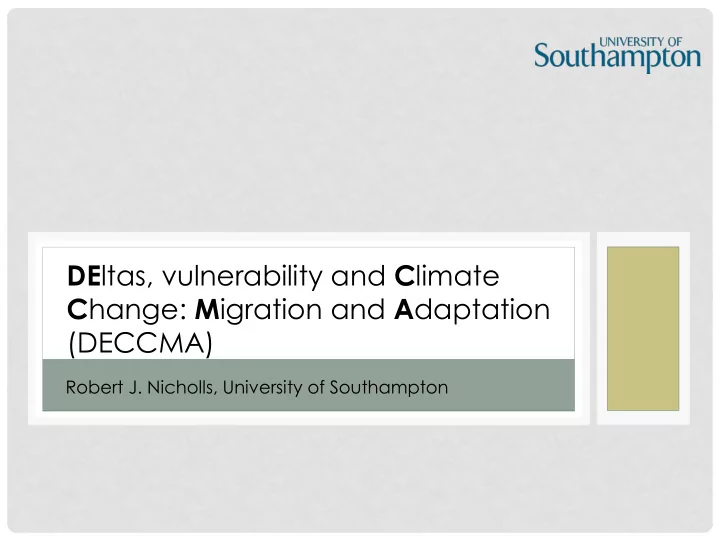

DE ltas, vulnerability and C limate C hange: M igration and A daptation (DECCMA) Robert J. Nicholls, University of Southampton
THREATENED DELTAS With Sea-level Rise and Subsidence Nile and Ganges-Brahmaputra Deltas (Broadus et al., 1986); Milliman et al ., 1989) People displaced by 2100 (2012 population): 16 to 20 million (Egypt) 42 to 54 million (Bangladesh)e
THREATENED DELTAS (Ericson et al (2006); IPCC AR4, 2007) Population potentially displaced by current sea-level trends to 2050 (E xtreme >1 million; high =1 million-50,000; medium 50,000 – 5,000 people) Global population in deltas is about 500 million people
ENVIRONMENTAL REFUGEES?
River Floods/ Sediment Supply Sedimentation, Climate Tectonics, Variability Subsidence, NATURAL Cyclones/ Lecture 4. Climate change and the PROCESSES integrated coastal system. Wednesday Marine Processes 25 July 2007
HUMAN ‘PROCESSES’ River Floods/ Sediment Supply Changing catchment management Sedimentation, ‘Global Climate Tectonics, Climate Variability Subsidence, Change’ Fundamental Population and Economic Change NATURAL Cyclones/ Lecture 4. Climate change and the PROCESSES integrated coastal system. Wednesday Marine Processes 25 July 2007
OTHER DELTA ISSUES Taking Bangladesh as an example
DELTA SUMMARY • Complex systems with large vulnerable populations • Multiple drivers at multiple scales • Rapid resultant change, including significant migration • (Lack of political representation – not an automatic focus for policy) • Climate change needs to be analysed in this dynamic context, including established and emerging migration • As climate change and sea-level rise increases, so the range of sustainable adaptation choices diminishes
DECCMA AIMS (DE ltas, Vulnerability and C limate C hange: M igration and A daptation) 1. to assess migration as an adaptation in deltaic environments under a changing climate; 2. to deliver policy support on sustainable gender-sensitive adaptation in deltaic areas. OR Better understand in deltas: 1. migration processes, including the role of climate change 2. adaptation approaches, including the possible role of migration. This will take a participatory and adaptive pathway approach that addresses gender dimensions?
DECCMA OBJECTIVES 1. to understand the governance mechanisms that promote or hinder migration of men and women in deltas; 2. to identify climate change impact hotspots in deltas where vulnerability will grow and adaptation will be needed; 3. to understand the conditions that promote migration and its outcomes, as well as gender-specific adaptation options for trapped populations, via surveys; 4. to understand how climate-change-driven global and national macro-economic processes impact on migration of men and women in deltas; 5. to produce an integrated systems-based bio-physical and socio-economic model to investigate potential future migration under climate change; 6. to conceptualise and evaluate migration within a wide suite of potential adaptation options at both the household and delta level; 7. to identify feasible and desirable adaptation options and support implementation of stakeholder-led gender-sensitive adaptation policy choices.
DELTA STUDY SITES Population potentially displaced by current sea-level trends to 2050 according to Ericson et al (2006) Extreme >1 million; high =1 million-50,000; medium 50,000 – 5,000 people
STUDY SITES a b c d (a)Ganges-Brahmaputra delta, Bangladesh/India; (b)Manhandi delta, India; (c)Nile delta, Egypt; (d)Volta delta, Ghana
DELTA SITE COMPARISON GBM Delta, Bangladesh Nile Delta, Egypt Mahanadi Delta, India Volta Delta, Ghana and India Rivers/catchmen Ganges, Brahmaputra, White and Blue Nile Mahanadi, Brahmnai & Black Volta, White Volta t area (10 3 km 2 ) Meghna (1,730) (3,870) Baitarani (141) and Red Volta (398) Size of delta 87.3 (66% in Bangladesh; 24.9 5.91 2.43 (10 3 km 2 ) 33% in West Bengal, India) Annual (and 35,500 (138,700 - average 2,830 (NA -- Aswan Dam) 1800 (45,000) 900 (NA -- dam at peak) discharge annual peak) Akosombo) (m 3 /s) Sediment input 1 x10 9 Negligible since dam 29.8 x 10 6 Negligible since dam (tonnes/yr) construction (see below) construction (see below) Catchment Significant, but less High Aswan Dam in 1964 Hirakud Dam in 1957 Akosombo Dam (1961- interventions affected than other three stopped all upstream 1965) stopped all upstream deltas influence influence Current RSLR 11.0 4.4 3.3 3.0 (mm/yr) Key current land Floods, erosion, low dry Urbanisation (everywhere), Floods, erosion, low dry Erosion (especially at Keta), issues and season availability, water widespread salinization season availability, water floods, salinisation hazards logging, salinisation, storm logging, salinisation, storm surge surge Typical crops Rice (main crop), wheat, Rice, maize, wheat, Rice (main crop), wheat, Shallot, maize, cassava, jute, pulses, oilseeds, tomato, alfalfa jute, pulses, oilseeds, tomatoes, okro, yams and sugarcane, potatoes, sugarcane, potatoes, rice. vegetables, spices vegetables, spices Delta population 111 47.8 3.88 0.38 (x10 6 people) Typical Agriculture, fisheries, urban Rural areas -- agriculture Agriculture, fisheries Fisheries, agriculture and livelihoods workers/labourers, and fisheries; Urban -- salt production mangroves (Sunderbahns) industry and services Main cities in Khulna, Kolkata Alexandria, plus 13 other Bhubaneswar, Cuttack and Accra (not in delta) delta cities Puriare
DECCMA CONSORTIUM Five lead institutions: • Northern: University of Southampton, UK and 8 partners (Lead: Robert Nicholls) • Bangladesh: Bangladesh University of Engineering and Technology and 5 partners (Lead: Munsur Rahman) • India: Jadavpur University and 4 partners (Lead: Tuhin Ghosh) • Egypt: National Authority of Remote Sensing and Space Sciences and 7 partners (Lead: Belal El Leithy) • Ghana: University of Ghana and 7 partners (Lead: Samuel Codjoe)
DECCMA WORK PACKAGE STRUCTURE
DECCMA OUTCOMES The analysis will guide sustainable and equitable development of deltas and will: 1. identify gender-differentiated stakeholder- relevant scenarios of local/regional/delta level vulnerability to climate change; 2. identify options for effective climate adaptation by the poorest groups in deltas; and 3. lead to the development of gender-sensitive adaptation funding proposals in the four deltas.
LINKS TO CARRIA Suggested links • Climate change (UK Met Office) • Gender issues (Kulima Integrated Development Solutions) • Macro-economics (Basque Centre for Climate Change) Links to other projects • Catchment modelling and analysis • Ganges, Brahmaputra, Meghna (GBM delta) • White and Blue Nile (Nile delta) • Mahanadi, Brahmnai & Baitarani (Mahanadi delta) • Black Volta, White Volta and Red Volta (Volta delta)
DE ltas, vulnerability and C limate C hange: M igration and A daptation (DECCMA) Robert J. Nicholls, University of Southampton
Recommend
More recommend